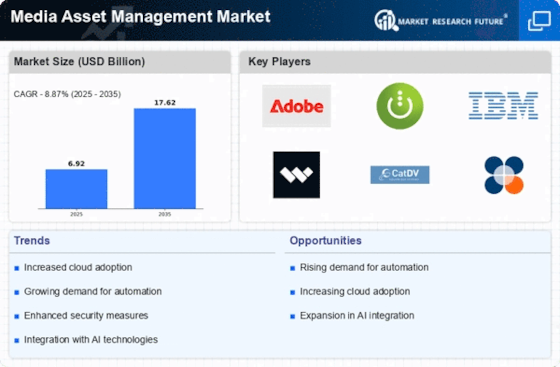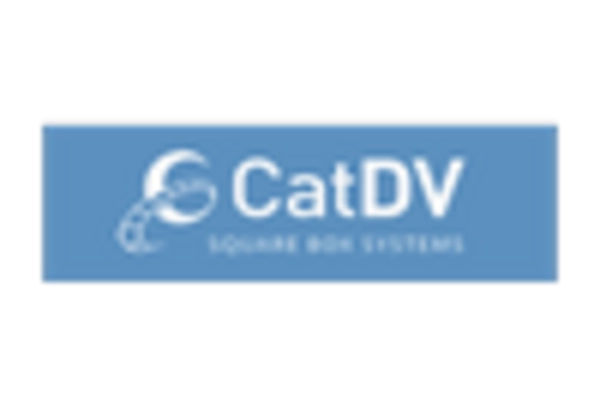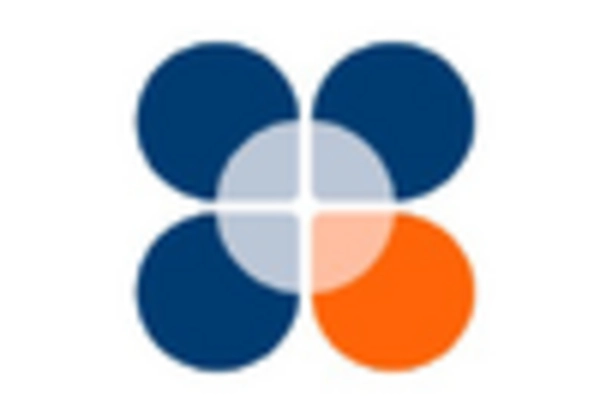Rising Demand for Digital Content
The increasing consumption of digital content across various platforms appears to be a primary driver for the Media Asset Management Market. As consumers gravitate towards streaming services, social media, and online platforms, the need for efficient management of media assets becomes paramount. Reports indicate that the digital content creation market is projected to reach substantial figures, with a significant portion attributed to video content. This surge necessitates robust media asset management solutions to streamline workflows, enhance accessibility, and ensure compliance with licensing agreements. Consequently, organizations are investing in advanced media asset management systems to optimize their content delivery and maintain a competitive edge in the rapidly evolving digital landscape.
Increased Focus on Brand Management
The heightened emphasis on brand management and consistency is influencing the Media Asset Management Market. Companies are recognizing the importance of maintaining a cohesive brand image across various channels, which necessitates the effective organization and distribution of media assets. As brands expand their reach, the complexity of managing diverse media assets increases. Data indicates that organizations are investing in media asset management solutions to ensure that their branding materials are consistently represented across all platforms. This trend underscores the critical role of media asset management in safeguarding brand integrity and enhancing customer perception, ultimately driving market growth.
Growth of E-commerce and Online Retail
The expansion of e-commerce and online retail channels is likely to propel the Media Asset Management Market. As businesses increasingly rely on digital marketing strategies, the demand for high-quality media assets, such as images and videos, intensifies. E-commerce platforms require effective media asset management to ensure that product images and promotional videos are readily available and easily accessible. Market data suggests that the e-commerce sector is experiencing exponential growth, with projections indicating a continued upward trajectory. This growth compels retailers to adopt sophisticated media asset management solutions to enhance customer engagement and streamline their marketing efforts, thereby driving the overall market.
Regulatory Compliance and Data Security
The increasing importance of regulatory compliance and data security is a critical driver for the Media Asset Management Market. Organizations are under pressure to adhere to various regulations regarding data protection and intellectual property rights. As a result, there is a growing need for media asset management solutions that not only facilitate the organization of media assets but also ensure compliance with legal requirements. Market data indicates that companies are prioritizing investments in secure media asset management systems to mitigate risks associated with data breaches and copyright infringements. This focus on compliance and security is likely to drive demand for advanced media asset management solutions in the foreseeable future.
Technological Advancements in Media Management
Technological innovations are reshaping the Media Asset Management Market, as advancements in cloud computing, artificial intelligence, and machine learning offer new capabilities for managing media assets. These technologies enable organizations to automate processes, enhance searchability, and improve collaboration among teams. The integration of AI-driven tools allows for more efficient tagging and categorization of media assets, which can significantly reduce time spent on manual tasks. Market analysis suggests that the adoption of these technologies is on the rise, as businesses seek to leverage the benefits of automation and improved efficiency. This trend is likely to continue, further propelling the growth of the media asset management sector.

















Leave a Comment